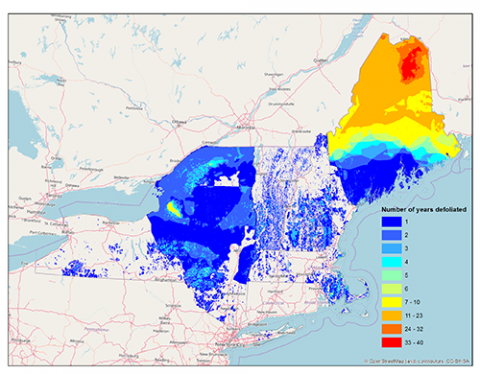Disturbance Dynamics Across the Northern Forest: Synthesizing NSRC Studies of Ecosystem Change Within a Regional Forest Health Mapping Framework

NSRC researchers conducted a geospatial synthesis of forest disturbance research and monitoring data in the Northern Forest region (northern New York, Vermont, New Hampshire and Maine). This resulted in two products: 1) an analysis of disturbance trends and patterns interpreted from aerial detection survey (ADS) data, and 2) an online portal integrating data from previous NSRC projects and forest health ADS data in a seamless, interactive mapping framework, called the Northeastern Forest Health Atlas. Data are available for field-based research findings on disturbance-related studies, and historical damage polygons mapped through the ADS and insect and disease surveys (1918-2016).
Researchers used the atlas to investigate regional disturbance patterns spanning 17 years (2000-2016). Disturbance patterns include damage type, causal agent, and agent category. The analysis indicated that approximately 11.0 million ha of forestlands (10% of the study region) have experienced at least one disturbance event over the 17-year period, annually averaging 3.4% ± 1.1% of the region’s total forestland. Insects caused the greatest amount of mapped disturbance (8,097,969 ha), and a relatively small number of invasive insects (19 species) were responsible for half of this damage.
Within the region, researchers identified several hotspots with multiple disturbance events, with some locations experiencing as many as 12 years of disturbance in the 17-year record. Repeated insect disturbance often co-occurred with other causal agents (typically abiotic), indicating that secondary stressors are important contributors to forest dynamics. Because climate change may alter the types, intensities, and frequencies of forest disturbance, quantifying baseline patterns is critical for detecting shifts in disturbance dynamics and developing adaptive management strategies.
